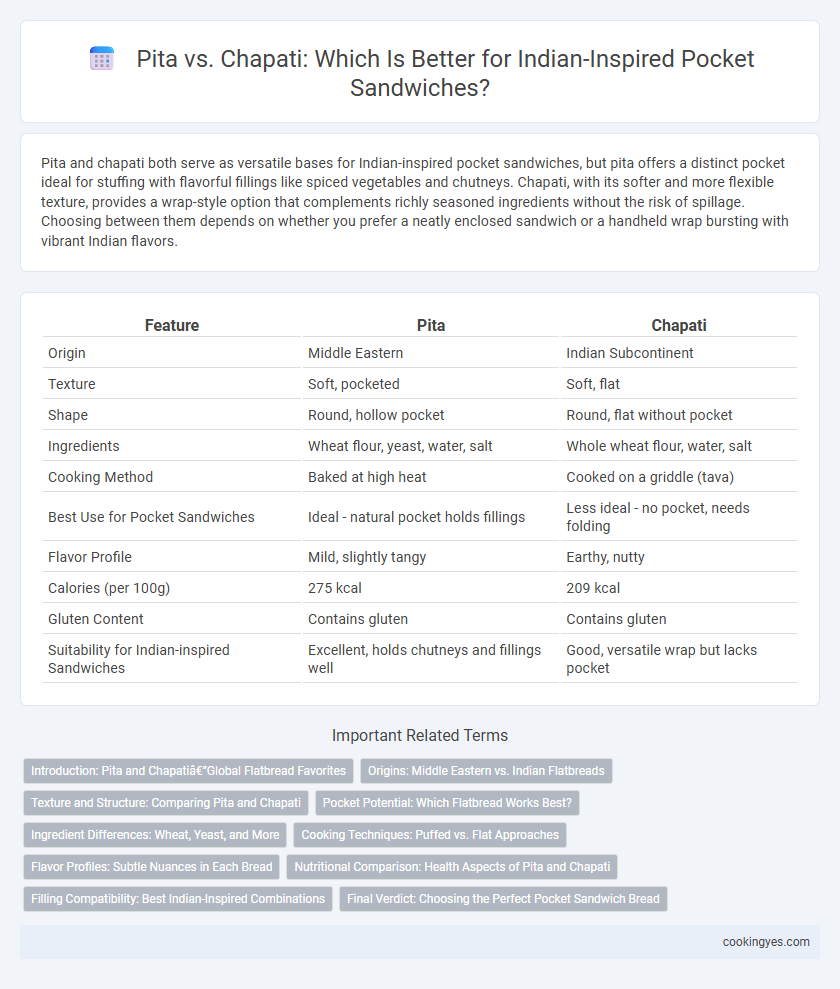Pita and chapati both serve as versatile bases for Indian-inspired pocket sandwiches, but pita offers a distinct pocket ideal for stuffing with flavorful fillings like spiced vegetables and chutneys. Chapati, with its softer and more flexible texture, provides a wrap-style option that complements richly seasoned ingredients without the risk of spillage. Choosing between them depends on whether you prefer a neatly enclosed sandwich or a handheld wrap bursting with vibrant Indian flavors.
Table of Comparison
| Feature | Pita | Chapati |
|---|---|---|
| Origin | Middle Eastern | Indian Subcontinent |
| Texture | Soft, pocketed | Soft, flat |
| Shape | Round, hollow pocket | Round, flat without pocket |
| Ingredients | Wheat flour, yeast, water, salt | Whole wheat flour, water, salt |
| Cooking Method | Baked at high heat | Cooked on a griddle (tava) |
| Best Use for Pocket Sandwiches | Ideal - natural pocket holds fillings | Less ideal - no pocket, needs folding |
| Flavor Profile | Mild, slightly tangy | Earthy, nutty |
| Calories (per 100g) | 275 kcal | 209 kcal |
| Gluten Content | Contains gluten | Contains gluten |
| Suitability for Indian-inspired Sandwiches | Excellent, holds chutneys and fillings well | Good, versatile wrap but lacks pocket |
Introduction: Pita and Chapati—Global Flatbread Favorites
Pita and chapati are beloved global flatbreads that serve as versatile bases for Indian-inspired pocket sandwiches. Pita's pocket structure naturally holds fillings, making it ideal for stuffed sandwiches, while chapati's flexible and thin texture offers a softer wrap experience. Both flatbreads bring distinct cultural flavors and textures, enriching the fusion of traditional Indian spices with modern sandwich creations.
Origins: Middle Eastern vs. Indian Flatbreads
Pita and chapati originate from distinct culinary traditions, with pita rooted in Middle Eastern cuisine and chapati belonging to Indian flatbread heritage. Pita is characterized by its pocket that forms during baking, ideal for stuffing with fillings, while chapati is an unleavened, soft flatbread typically served alongside curries. Their different textures and preparation methods reflect their cultural origins, influencing their use in Indian-inspired pocket sandwiches.
Texture and Structure: Comparing Pita and Chapati
Pita offers a soft, pocket-like structure that naturally holds fillings, making it ideal for Indian-inspired pocket sandwiches, while chapati has a denser, pliable texture that folds rather than pockets. The airy pocket of pita prevents fillings from spilling, enhancing convenience and eating experience. Chapati's chewy consistency absorbs sauces well but requires careful folding to contain ingredients securely.
Pocket Potential: Which Flatbread Works Best?
Pita offers the ideal pocket potential for Indian-inspired pocket sandwiches due to its natural pocket that easily holds fillings like spiced paneer or curried vegetables without spilling. Chapati, while softer and more pliable, lacks a built-in pocket and requires careful folding, which can lead to leakage and messiness. For hassle-free, spill-resistant Indian-style sandwiches, pita's structure consistently outperforms chapati in maintaining integrity and convenience.
Ingredient Differences: Wheat, Yeast, and More
Pita and chapati differ primarily in their ingredients and fermentation process, influencing texture and flavor in Indian-inspired pocket sandwiches. Pita is typically made with wheat flour, water, yeast, and salt, resulting in a soft, leavened bread that puffs up to create a pocket ideal for fillings. Chapati uses whole wheat flour (atta), water, and salt without yeast, producing an unleavened, thinner flatbread with a denser texture, making it less pocket-like but perfect for wrapping ingredients tightly.
Cooking Techniques: Puffed vs. Flat Approaches
Pita bread is characterized by its puffed, hollow pocket created through high-heat baking, which allows for easy stuffing with Indian-inspired fillings, whereas chapati remains flat and pliable due to dry roasting on a griddle without leavening agents. The puffed technique of pita results in a pocket that traps steam, making it ideal for sandwich assembly and preventing spillage. In contrast, chapati's flat cooking method produces a flexible wrap suitable for folding or rolling, offering a different texture and eating experience.
Flavor Profiles: Subtle Nuances in Each Bread
Pita offers a distinct pocket with a mild, slightly tangy flavor derived from its wheat-based dough, lending a light chewiness that complements robust Indian fillings without overpowering spices. Chapati, made from whole wheat flour, presents a more earthy and nutty taste, with a soft, pliable texture that absorbs curry sauces, enhancing the overall flavor profile of Indian-inspired pocket sandwiches. Choosing between pita and chapati depends on the desired balance between subtle tanginess and rich wheat flavor to elevate the sandwich experience.
Nutritional Comparison: Health Aspects of Pita and Chapati
Pita and chapati both offer distinct nutritional profiles ideal for Indian-inspired pocket sandwiches, with chapati generally providing higher fiber content due to whole wheat flour, aiding digestion and blood sugar control. Pita, often made from refined flour, contains fewer calories and less fat, making it a lighter option for calorie-conscious consumers. Both breads supply essential carbohydrates and proteins, but chapati's complex carbohydrates support sustained energy release, while pita's pocket structure enhances convenience for stuffing with nutrient-dense fillings.
Filling Compatibility: Best Indian-Inspired Combinations
Pita's pocket structure holds thick Indian-inspired fillings like spiced chickpeas, paneer tikka, and curried potatoes without leakage, making it ideal for robust flavors. Chapati's pliable texture suits lighter fillings such as aloo bhaji or vegetable sabzi, offering a soft bite that blends well with delicate spices. Pita pairs best with creamy raita and tangy chutneys, enhancing bold tastes, while chapati complements subtle, aromatic blends that benefit from gentle wrapping.
Final Verdict: Choosing the Perfect Pocket Sandwich Bread
Pita offers a sturdy, pocketed structure ideal for holding Indian-inspired fillings like spiced chickpeas, paneer, or curried vegetables without spilling, while chapati provides a softer, thinner wrap that complements delicate fillings but lacks a true pocket. For sandwich portability and a balanced texture that can handle robust Indian flavors, pita stands out as the superior choice. Opt for pita when you want a versatile bread that enhances the traditional pocket sandwich experience with Indian cuisine.
Pita vs Chapati for Indian-inspired pocket sandwiches Infographic

 cookingyes.com
cookingyes.com